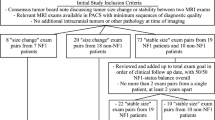Abstract
Optic pathway glioma (OPG) has an unpredictable course, with poor correlation between conventional imaging features and tumor progression. We investigated whether diffusion-weighted MRI (DWI) predicts the clinical behavior of these tumors. Twelve children with OPG (median age 2.7 years; range 0.4–6.2 years) were followed for a median 4.4 years with DWI. Progression-free survival (time to requiring therapy) was compared between tumors stratified by apparent diffusion coefficient (ADC) from initial pre-treatment scans. Tumors with baseline ADC greater than 1,400 × 10−6 mm2/s required treatment earlier than those with lower ADC (log-rank p = 0.002). In some cases, ADC increased leading up to treatment, and declined following treatment with surgery, chemotherapy, or radiation. Baseline ADC was higher in tumors that eventually required treatment (1,562 ± 192 × 10−6 mm2/s), compared with those conservatively managed (1,123 ± 114 × 10−6 mm2/s) (Kruskal–Wallis test p = 0.013). Higher ADC predicted earlier tumor progression in this cohort and in some cases declined after therapy. Evaluation of OPG with DWI may therefore be useful for predicting tumor behavior and assessing treatment response.




Similar content being viewed by others
References
Binning MJ, Liu JK, Kestle JRW et al (2007) Optic pathway gliomas: a review. Neurosurg Focus 23:E2
Ahn Y, Cho B-Y, Kim S-K et al (2006) Optic pathway glioma: outcome and prognostic factors in a surgical series. Child Nerv Syst 22:1136–1142
Le Bihan D, Breton E, Lallemand D et al (1996) MR imaging of intravoxel incoherent motions: application to diffusion and perfusion in neurologic disorders. Radiology 161:401–407
Tien RD, Felsberg GJ, Friedman H et al (1994) MR imaging of high-grade cerebral gliomas: value of diffusion-weighted echoplanar pulse sequences. AJR 162:671–677
Sugahara T, Korogi Y, Kochi M et al (1999) Usefulness of diffusion-weighted MRI with echo-planar technique in the evaluation of cellularity in gliomas. J Magn Reson Imaging 9:53–60
Filippi CG, Bos A, Nickerson JP et al (2012) Magnetic resonance diffusion tensor imaging (MRDTI) of the optic nerve and radiations at 3T in children with neurofibromatosis type I (NF-1). Pediatr Radiol 42:168–174
Jost SC, Ackerman JW, Garbow JR et al (2008) Diffusion-weighted and dynamic contrast-enhanced imaging as markers of clinical behavior in children with optic pathway glioma. Pediatr Radiol 38:1293–1299
Crouse NR, Dahiya S, Gutmann DH (2011) Rethinking pediatric gliomas as developmental brain abnormalities. Current Topics in Developmental Biology, vol. 94. Elsevier/Academic Press, New York
Hoyt WF, Baghdassarian SA (1969) Optic glioma of childhood. Natural history and rationale for conservative management. Br J Ophthalmol 53:793–798
Conflict of interest
This study was performed without grant support or industry sponsorship. There are no financial disclosures or conflicts of interest.
Author information
Authors and Affiliations
Corresponding author
Rights and permissions
About this article
Cite this article
Yeom, K.W., Lober, R.M., Andre, J.B. et al. Prognostic role for diffusion-weighted imaging of pediatric optic pathway glioma. J Neurooncol 113, 479–483 (2013). https://doi.org/10.1007/s11060-013-1140-4
Received:
Accepted:
Published:
Issue Date:
DOI: https://doi.org/10.1007/s11060-013-1140-4




